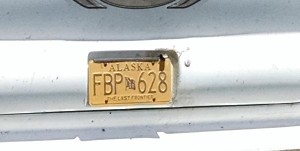By the numbers:
- 216 miles, from Shreveport LA to Vicksburg MS – 3609 total miles for the trip.
- highest temp: 95 but our weather app said the “real feel” was 105 and it “really felt” that hot.
- One new state, Mississippi, but no new license plates. 10 total states for the trip, plus I think we could see Arkansas from our most northern point today.
- Two new national parks: Poverty Point National Monument and Vicksburg National Military Park – 20 total park sites for the trip.
- about 12 – the number of different electronic and/or battery powered devices I worried about when a thunderstorm rolled through and knocked the power out at our hotel for a little while.
- 535 feet – the highest elevation above sea level in the entire state of Louisiana, near Shreveport where we started this morning. That’s about the same height at the top of the hill we live on in Seattle.
Poverty Point was the kind of National Park site I really love. All about an aspect of our nation’s history that I had never heard about before and all very well presented and preserved. 
We tend to learn in school about the early middle eastern cultures, like the Egyptians that we think of as early precursors to our modern culture. Here in Louisiana, at about the same time as the Egyptian pyramid builders there was a mound building culture that was probably the precursor to many of the later Native American cultures on this continent. The Mounds they build were as high as 750 feet and huge. The major mound was in the shape of a bird though you can only tell that from aerial photography today. Yet these folks planned and build this and very intricate other patterns of mounds on which they both lived and grew crops without any way to see their work from above. Some  sophisticated math was involved. The mound was built by carrying baskets full of soil from nearby areas up the mounds and building the structure layer by layer. With baskets of soil weighing about 50 pounds each the estimate is that it took about 15 million baskets full to build just the one mound.
sophisticated math was involved. The mound was built by carrying baskets full of soil from nearby areas up the mounds and building the structure layer by layer. With baskets of soil weighing about 50 pounds each the estimate is that it took about 15 million baskets full to build just the one mound.
Also, the culture involved major networks of trade up and down the Mississippi, with rocks found in this area known to have originated as far away as Iowa, Illinois and even above the Great Lakes region in Canada. All of this occurred 2000 years B.C. I had no idea. Later generations of this same mound building culture built the Effigy Mounds in Eastern Iowa.
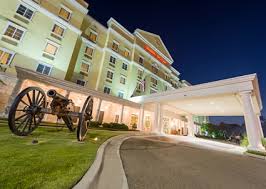
You can tell you are in the Civil War History part of the country when your hotel has a canon as a lawn decoration.
We will see more of Vicksburg tomorrow, but one last tidbit related to elevation. All across Louisiana the entire state seemed very flat. Suddenly we cross the Mississippi and on the this side of the river the city of Vicksburg is quite hilly. In fact the cliffs by the river are about 300 feet high, one of the reasons Vicksburg was the last stronghold on the Mississippi for the South in the Civil War.
 es covers a lot of history but mostly a large number of old plantation sites in this area. We visited one specific site at the Oakley Plantation. This part of our country’s history is so sad. I have a hard time understanding the attraction that some people have to this era. Being here while so many conversations are going on about he confederate flag is very odd. The argument I have heard on news shows several times in the past week is that the Confederate flag is not about racism, it is about states’ rights. But I have to ask when I hear that phrase, “States’ rights to do what?” The civil war wasn’t fought over states’ rights to build roads, the right to provide schools or hospitals for citizens, or about how a state generally chooses to tax or spend its money. It was specifically over the “states’ right” to continue a system of support for one group of people to enslave another group of people and treat them as property. I don’t know if the confederate flag defenders don’t get that or if they don’t want to get that. The confederate flag is part of history but I have a hard time seeing how it should be the official part of any level of government anywhere in the currrent day United States.
es covers a lot of history but mostly a large number of old plantation sites in this area. We visited one specific site at the Oakley Plantation. This part of our country’s history is so sad. I have a hard time understanding the attraction that some people have to this era. Being here while so many conversations are going on about he confederate flag is very odd. The argument I have heard on news shows several times in the past week is that the Confederate flag is not about racism, it is about states’ rights. But I have to ask when I hear that phrase, “States’ rights to do what?” The civil war wasn’t fought over states’ rights to build roads, the right to provide schools or hospitals for citizens, or about how a state generally chooses to tax or spend its money. It was specifically over the “states’ right” to continue a system of support for one group of people to enslave another group of people and treat them as property. I don’t know if the confederate flag defenders don’t get that or if they don’t want to get that. The confederate flag is part of history but I have a hard time seeing how it should be the official part of any level of government anywhere in the currrent day United States.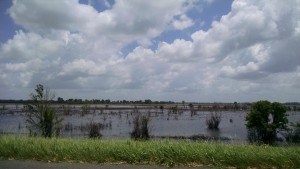 l today as we just managed to finish our day before a thunder storm rolled through the area.
l today as we just managed to finish our day before a thunder storm rolled through the area. otel was this sign. We had a great dinner and I told the waitress I had only one complaint. Their prime rib is so good I can never bring myself to try anything else on the menu.
otel was this sign. We had a great dinner and I told the waitress I had only one complaint. Their prime rib is so good I can never bring myself to try anything else on the menu.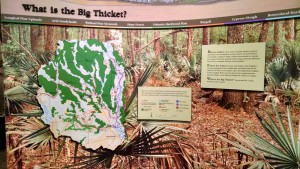 he day traveling in our air-conditioned car. This part of the country is so lush and green. It is really quite beautiful. We learned at the Big Thicket that for many years the Thicket was home to relatively few people, but that they could live a pretty reasonable life totally in the woods. The area is full of such a diverse range of plants, trees, birds, insects and animals that resourceful people could live a very self-sustained life just from the resources around them. In addition to using natural items for food and clothing and shelter, many medicines could be obtained from the Thicket.
he day traveling in our air-conditioned car. This part of the country is so lush and green. It is really quite beautiful. We learned at the Big Thicket that for many years the Thicket was home to relatively few people, but that they could live a pretty reasonable life totally in the woods. The area is full of such a diverse range of plants, trees, birds, insects and animals that resourceful people could live a very self-sustained life just from the resources around them. In addition to using natural items for food and clothing and shelter, many medicines could be obtained from the Thicket.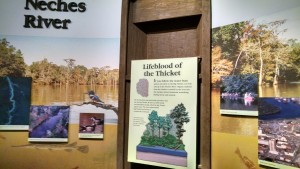 t the people living in the Big Thicket was that many of us today might look upon such an existence as a pretty low level hard scrabble way of life, but they definitely lived according to Milton Wrights advice. Not needing or expecting support or help from anyone else. Of course we do not live in a world where everyone ascribes to that approach. At the point at which it was realized that the Big Thicket contained Big Timber and Big Oil, then Big Money stepped in, booted out many of the people living there
t the people living in the Big Thicket was that many of us today might look upon such an existence as a pretty low level hard scrabble way of life, but they definitely lived according to Milton Wrights advice. Not needing or expecting support or help from anyone else. Of course we do not live in a world where everyone ascribes to that approach. At the point at which it was realized that the Big Thicket contained Big Timber and Big Oil, then Big Money stepped in, booted out many of the people living there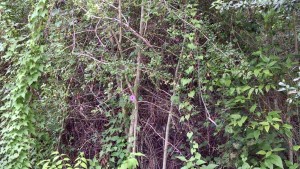
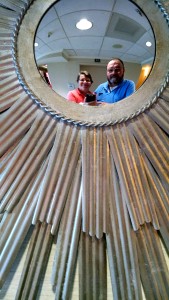 st part of travels to new places, whether it be physical travels to National Parks, or intellectual travels to other places and times like 1903 at Kitty Hawk, is when we can use those new experiences to reflect on ourselves and what we can do to make our work a better place.
st part of travels to new places, whether it be physical travels to National Parks, or intellectual travels to other places and times like 1903 at Kitty Hawk, is when we can use those new experiences to reflect on ourselves and what we can do to make our work a better place.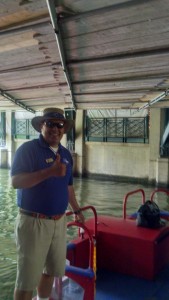 Joseph D. He was a our tour guide on a river boat ride around the river walk area of downtown San Antonio. Great tour, reasonable price, and great tour guide. We learned a lot and had many good laughs along the way. I hope Seattle can learn a few things from San Antonio as the city tries to figure out what to do with it’s waterfront after the viaduct comes down. Between Baltimore Harbor and the San Antonio river walk Seattle could learn some good lessons.
Joseph D. He was a our tour guide on a river boat ride around the river walk area of downtown San Antonio. Great tour, reasonable price, and great tour guide. We learned a lot and had many good laughs along the way. I hope Seattle can learn a few things from San Antonio as the city tries to figure out what to do with it’s waterfront after the viaduct comes down. Between Baltimore Harbor and the San Antonio river walk Seattle could learn some good lessons.
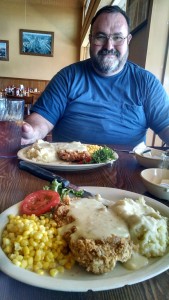

 ential homes when we were living in DC so are continuing to see others as we travel. In addition, George W is a distant cousin of mine. My only comment is that contrary to Wilbur Wright’s advice we don’t have any choice about who are parents or our blood relatives are.
ential homes when we were living in DC so are continuing to see others as we travel. In addition, George W is a distant cousin of mine. My only comment is that contrary to Wilbur Wright’s advice we don’t have any choice about who are parents or our blood relatives are.